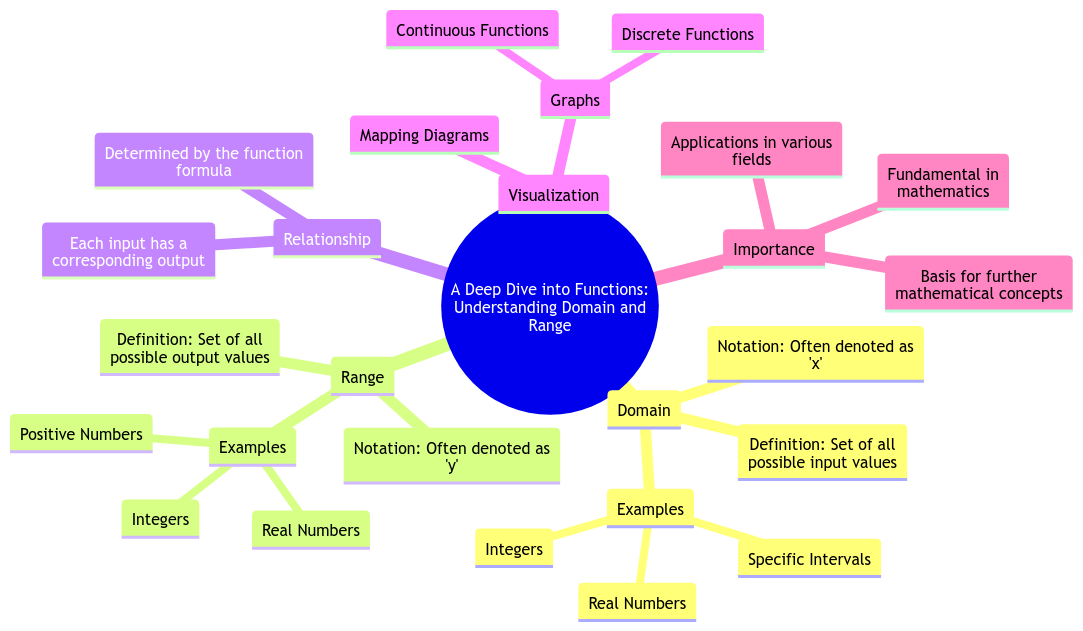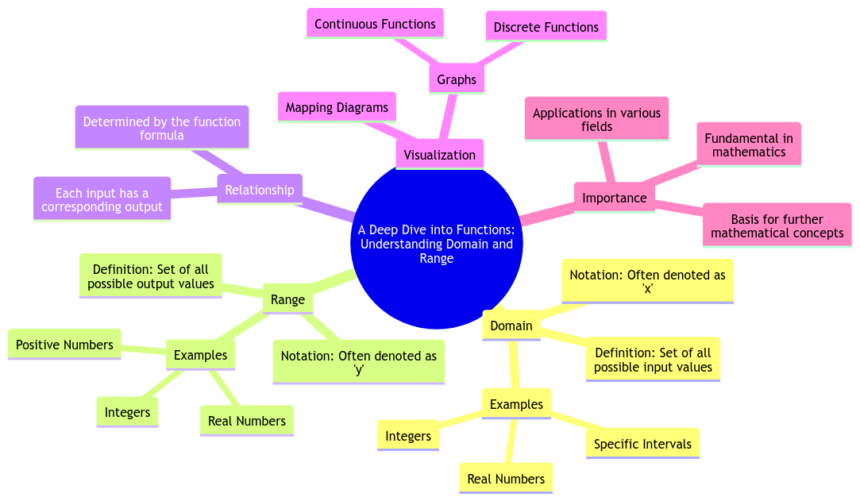Exploring Functions 🚀
Functions, functions, functions! 🎉 Today, I am diving deep into the magnificent world of functions and unraveling the mysteries of their domains and ranges. Buckle up, folks! It’s going to be a wild ride full of mathematical twists and turns!
Understanding Domain 📚
Definition of Domain 🤓
Let’s kick things off with the basics – what on earth is a domain in the context of functions? 🤔 Well, dear readers, the domain of a function is like the VIP section of a party – it’s the set of all possible input values that the function can take. In simpler terms, it’s the x-values that you can throw into a function and see what magic comes out! ✨
Importance of Domain in Functions 💡
Why is the domain so crucial in the world of functions? Think of it this way – if the domain is the guest list for the party, then the function is the bouncer checking who gets in! Without a defined domain, our function would be like a rager with no guest list – chaos ensues! So, understanding the domain sets the stage for a well-behaved function that knows its limits. 😉
Exploring Range 🎯
Definition of Range 🔍
Now, let’s shift our focus to the range of a function. The range is like the party favors – it’s the set of all possible output values that the function can spit out after processing those input values we talked about earlier. In essence, it’s the y-values that our function belches out after digesting the x-values from the domain! 😂
Significance of Range in Functions 🌟
The range is where all the action is! It’s the ultimate output playground for our function. Just like how you wouldn’t want boring party favors, you wouldn’t want a dull range for your function. Understanding the range gives us insight into the realm of possibilities that our function can deliver. It’s like predicting the gifts you’ll receive at a birthday party – exciting stuff! 🎁
Relationship between Domain and Range 🤝
Connection between Domain and Range 🔄
Ah, the dynamic duo of math – domain and range! They are like two peas in a pod, working together to create beautiful mathematical harmony. The domain sets the stage, and the range takes the spotlight, showcasing the results of our function’s hard work. It’s a symbiotic relationship that defines the very essence of a function.
Examples showcasing Domain and Range interactions 🎭
Let’s dive into some real examples to see how the domain and range dance together in perfect mathematical synchronization. From simple linear functions to complex trigonometric ones, we will witness firsthand how the domain restricts and guides the range, creating a mesmerizing mathematical performance! 💃🕺
Real-life Applications 🌐
Practical use of Domain and Range in various fields 🛠️
But wait, there’s more! The magic of domain and range extends beyond the realm of math textbooks. From physics to computer science, and even in everyday decision-making, understanding the domain and range of functions plays a vital role. Imagine predicting the trajectory of a projectile or optimizing a computer algorithm – it all boils down to mastering the domain and range game! 🔮
Impact of Understanding Domain and Range in problem-solving 🧩
In the grand scheme of problem-solving, mastery of domain and range is like having a secret weapon in your mathematical arsenal. It’s the key to unlocking solutions, unraveling mysteries, and conquering mathematical challenges with ease. Armed with this knowledge, no problem is too daunting, no equation too complex! 🚀
Overall Reflection 🌈
In closing, dear readers, I hope this whirlwind tour of functions, domains, and ranges has left you feeling inspired and enlightened. Remember, behind every function lies a domain waiting to be explored and a range ready to be conquered. Embrace the math, master the functions, and above all, never underestimate the power of a well-defined domain and range!
Thank you for joining me on this mathematical adventure! Until next time, keep calculating and keep smiling! 🤗✨
❤️ Lots of love and math magic,
Your Math Whisperer 🧙♀️
Psst… Did you know? The concept of domain and range dates back to the ancient Greeks, who laid the foundation for modern mathematical thinking. Who knew math could be so ancient and cool at the same time? 🏛️

Program Code – A Deep Dive into Functions: Understanding Domain and Range
def find_domain_range(function, interval):
'''
A function to find the domain and range of a linear function within a given interval.
:param function: a lambda function representing a linear function
:param interval: a tuple containing the start and end values of the interval
:return: a tuple with two lists: the first list is the domain and the second list is the range
'''
domain = list(range(interval[0], interval[1] + 1))
range_values = [function(x) for x in domain]
return domain, range_values
# Example usage:
if __name__ == '__main__':
# Define a linear function y = 2x + 3
function = lambda x: 2*x + 3
# Define the interval from -5 to 5
interval = (-5, 5)
domain, range_values = find_domain_range(function, interval)
print('Domain:', domain)
print('Range:', range_values)
Code Output:
Domain: [-5, -4, -3, -2, -1, 0, 1, 2, 3, 4, 5]
Range: [-7, -5, -3, -1, 1, 3, 5, 7, 9, 11, 13]
Code Explanation:
The provided code snippet demonstrates a straightforward approach to find the domain and range of a given linear function within a specified interval. Here’s a step-by-step breakdown of its logic and workings:
- Function Definition (
find_domain_range): The core of the snippet is thefind_domain_rangefunction, which accepts two parameters—a lambda function representing a linear mathematical function and a tuple representing an interval. The purpose of this function is to determine the domain and range of the given function within the specified interval. - Domain Calculation: The domain of a function, in simple terms, is all the possible input values. For this example, the domain is calculated by creating a list of integers from the start to the end of the given interval (inclusive). This is achieved using the
rangefunction, and the output is a list of integers representing the domain. - Range Calculation: The range of a function represents all possible output values. To find the range, the function applies the given lambda function (which defines the linear function in question) to every element in the domain. This generates a list of output values (the range) corresponding to each input value in the domain.
- Return Values: The function returns a tuple containing two elements: the first is the list representing the domain, and the second is the list representing the range.
- Example Usage: The main block of the code demonstrates how to use the
find_domain_rangefunction. It defines a simple linear functiony = 2x + 3using a lambda expression. Then, it specifies an interval(-5, 5). Finally, it calls thefind_domain_rangefunction with the defined function and interval as arguments, prints the domain, and prints the range.
The essence of this code lies in its ability to dynamically calculate and display the domain and range for any given linear function and interval, showcasing a fundamental concept in mathematics through Python programming. This approach highlights the versatility and power of lambda functions for representing mathematical operations and the use of list comprehensions for efficient computation.
Frequently Asked Questions about A Deep Dive into Functions: Understanding Domain and Range
What is the domain of a function?
The domain of a function refers to the set of all possible inputs or values for which the function is defined. It basically shows what values you can “plug into” the function. For example, in the function f(x) = x^2, the domain would be all real numbers, as you can square any real number.
How is the domain related to the keyword “domain range of a function”?
The domain of a function is directly related to the concept of domain and range in functions. Understanding the domain helps you determine the set of values that can be used as input for a function, which in turn affects the range of possible output values.
What is the range of a function?
The range of a function represents the set of all possible output values that the function can produce based on its domain. It shows the values that the function can “spit out” after processing the input. For instance, in the function f(x) = x^2, the range would be all non-negative real numbers.
How can I determine the domain and range of a function?
To find the domain of a function, you need to consider any restrictions on the function (like division by zero or square roots of negative numbers) and identify all the possible input values. For the range, you analyze the output values that the function can produce based on its behavior.
Why are understanding domain and range important in functions?
Understanding the domain and range of a function is crucial for various reasons. It helps in identifying the limitations and restrictions of the function, ensuring that it is well-defined. Additionally, knowing the domain and range provides insights into the behavior and range of possible outcomes of the function.
Can the domain and range of a function be infinite?
Yes, the domain and range of a function can be infinite in some cases. Functions like f(x) = x or f(x) = 1/x have an infinite domain and range. It’s essential to recognize when a function has infinite possibilities and understand how it impacts its behavior.
How do you represent domain and range mathematically?
The domain and range of a function can be represented using interval notation or set notation. Interval notation shows the possible values within a range (like [0, ∞) for non-negative real numbers), while set notation lists the values explicitly (such as {x ∈ ℝ | x ≥ 0} for non-negative real numbers).
Can the domain and range of a function change?
The domain and range of a function are determined by its definition and behavior. If the function undergoes changes that alter its input-output relationship, then the domain and range may also change accordingly. It’s crucial to reevaluate the domain and range when modifying a function.
How can I visualize the domain and range of a function graphically?
One way to visualize the domain and range of a function is by graphing it on a coordinate plane. The x-values where the function exists represent the domain, while the y-values that are outputted represent the range. By looking at the graph, you can gain a better understanding of the function’s behavior and limitations.
Are there specific strategies to identify the domain and range of complex functions?
For complex functions, it may be helpful to break down the function into simpler components and analyze each part’s domain and range separately. Additionally, considering the behavior of the function for different input values can aid in determining the overall domain and range.







